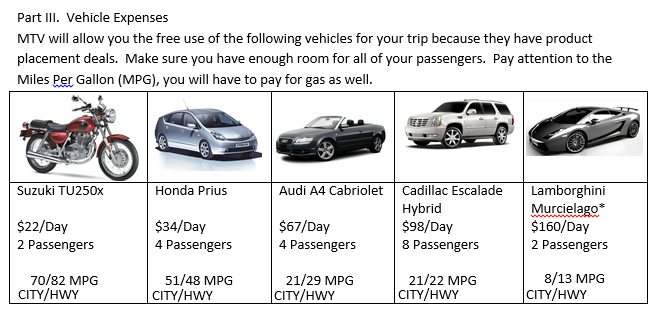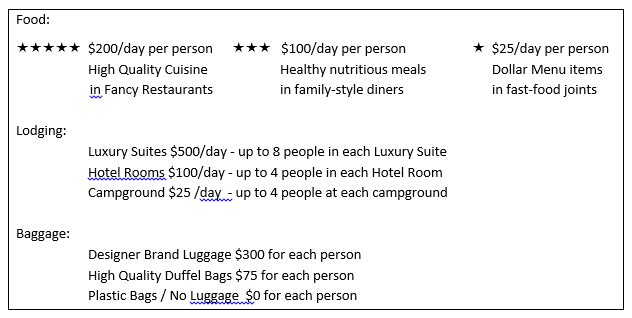Here’s the download info: Link to the Project Link to the Rubric (The rubric may not work on gmail accounts for districts that restrict the access of documents from outside the district.)
If you received this application it means you may be selected to appear on “Illest Road Trip of All-Time.” IRT is a new show where groups of people get $10,000 for a road trip that will be a “unique, life-changing, and eminently watchable experience”. The money you spend will mainly go towards two things your vehicle (rental and gas), and your daily expenses (Hotel and Food). Plan carefully, groups who do not plan to spend at least $9500 of the money will not be considered.
These are the first four lines of a Road Trip project that I have been using with kids for the past few years. This project is a good companion to a linear equations unit that could provide a rich context to help students think about using these equations to solve a real world problem, instead of just a “problem”. I have taught it for a bunch of years and it has been kind of popular among choices for students portfolios so I thought it might be good to have it online somewhere in case someone wants to try it out. That said it is still a work in progress and I would appreciate it if any readers could give any kind of feedback that would be good. Here is a link to the full project, but I’ll walk through it below. Let me know what you think!
Picking your travelers and choosing food and lodging.
The first 2 pages of the project asks kids to pick who they want to travel with. Since MTV can pull strings, their lists can include celebrities as well as their classmates and family. Students can pick anywhere between 1 and 8 people. This project is designed to have a lot of choice throughout so no two students have the same numbers. Next they think about what kind of food they want to eat and what kind of hotel they want to live in, and the luggage. When students decide how much to spend on their food, lodging, and baggage, they have to think in terms with variables since they don’t yet know how many days they need to spend on their trip.
Some students will make up a day that they think they are travelling and skip writing an the equation in order to just write down the number. This is a great to transition to thinking about variables by simply substituting the value they used for their days with ‘x’ or even the word ‘days’. Students may also calculate their total costs differently and it may good to ask people whether or not someone who wrote 100x + 400x + 300 will have the same cost as someone who wrote 300 + 500x and why someone might prefer one form over the other.
Picking Destination(s)
Next I have kids get on a computer and look up the different places they want to go on their trip. Much to their surprise, and mine to be honest, we don’t use google for this. Google just didn’t have better road directions in Mexico and some of Central America, so we use bing maps. Finding the miles and hours on the computer can be engaging, but could end up being a pretty empty without anything else for students to think about. I added a couple of other questions that would make sense to think about in the context.
If MTV only allows people to drive at maximium 10 Hours each day. What is the smallest number of days you could spend driving?
If your trip ends up being 31 days, and you spread the driving out over each day, how many hours would you spend driving each day?
Picking a Vehicle
As a native Detroiter, I had the most fun thinking about the cars for this trip, and I think the kids have the most fun picking their cars as well. 
Each car has a rental rate and the fuel efficiency. Get ready to do a little explanation of what Miles Per Gallon means by the way. In New York City, where some of my seniors and a few co-workers might never have a drivers license, this may be the first time they hear about City/Highway mileage. Once they get the miles per gallon, and the number of miles of the trip from the previous component, they should be able to find the total amount of money they will spend on gas during their trip. My worksheet may make it to easy for kids to understand the process, so this is a good place to edit the sheet if you want kids to do more reasoning around rates. Students can make a y=mx + b by combining the daily rate for renting a car with the total cost of the gas.
Using the equations to find the ideal trip
At this point the kids have two equations, for their vehicle and their food and lodging, and they have to find the trip with the right amount of days for a total costs between $9,500 and $10,000. This day looks like lots of calculating. I ask kids to use tables in a sort of guess and check approach, where they first find the cost of a trip for 7, 14, 21, and 28 days, and then narrow in on a range of days that should get them the total costs that they want. There is certainly more graceful ways that they could approach the problem, but I really want students to see how linear equations can be used to model a real situation.
The other thing I’m kind of mean about is that when a student doesn’t get their numbers to work out, they have to go back and change something in their trip in order to make it work. They rarely have any problem with it, and after I suggest the things that they alter in order to make it work, they get pretty engaged in seeing how their story will end.
Choosing a Sponsor
The next part of the project is not really necessary, but this maybe for you. Do you like having kids find equations from tables or pairs of points? What about solving systems of equations? Or do you have a hankering for some piece wise functions? Well having students analyze these sponsorship pay cycles may be for you!
In this situation the kids are going to choose which of these companies are going to pay them for completing the trip, and each company could the best for a different student in the class. The question of at what point someone should choose Pepsi over Coca-Cola leads one naturally to talk about the solution to the system of equations or the intersection of the two lines. If one were so inclined, they could even look at the feasible lines from each of the companies and create a piece-wise equation.
Let me know what you think!!!
So that is pretty much the whole project, so check it out and let me know what you think. This could be used as a whole packet kind of thing, but I’ve had a lot of success breaking it up into parts and having kids do it at the end of class throughout the unit, and you can use most of the parts in whatever order makes sense.
But seriously, if you’ve read this whole thing, and you have any ideas that you think would help me make better projects, I would really appreciate any feedback you could give me. It would really help, and all you have to do is leave a comment below. Thanks again!
Update: Here is a rubric that I have used in the past with the project. It is probably going to be something you’ll want to edit since you probably teach at a school that isn’t pass/fail for grading. Click Here For The Rubric
The last page of the rubric is helpful to give to students who struggle to write the cover letter. I usually tell them to just write a paragraph for each line of the cover letter and that helps them get started. Students who have written thorough explanations throughout the project will typically have the easiest time with the cover letter, so definitely encourage students to write about their process as they go along. I am really glad this is still helpful to people!


